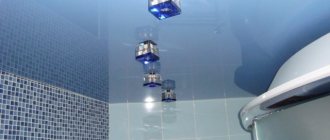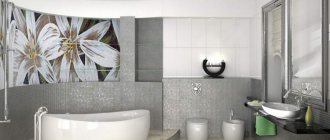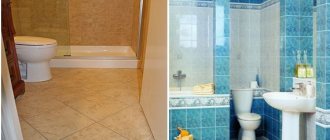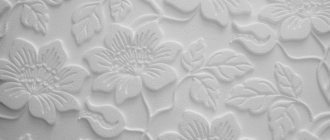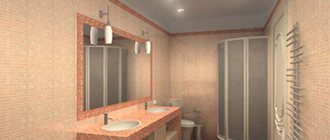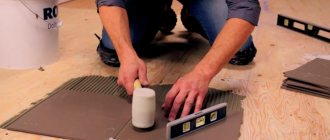For hundreds of years, tile has been one of the most popular finishing materials. However, many beginners still face the problem of installing bathroom tiles in corners. It is very important to correctly join the elements in this place; any defect will immediately be evident. To ensure that the result has a neat and harmonious appearance, use one of the methods discussed below.
Peculiarities
Corners for tiles perform protective, decorative and masking functions. The structure is usually installed immediately, but it also happens that it simply hides the broken part of the tile and at the same time prevents further destruction of the finish. The planks also protect against moisture penetration and the development of fungus and mold. Do not forget about the decorative purpose, because without borders a room with tiles on the outer corners would look “inadequate” in a modern way. Using corners, tile canvases and compositions are formed and transitions are designed. They are used with small mosaic fragments, large slabs on the floor of the balcony and bathroom. Ease of installation is also not the last nuance - anyone who has held the tools in their hands at least once can cope with the task. The hidden function is for human safety: without the corner, injuries would be possible. Consumers have access to a wide selection of parts for assembling structures.
Edge Trimming
To implement this method, you will need a professional tool. Its use will not only reduce time and labor costs, but also perform the work more accurately. The edge is trimmed at a 45 degree angle. You can use sandpaper, a tile cutter or a grinder for this.
The main condition for the successful completion of the entire event is careful preparation of the walls. They must be perfectly even, so that later you do not have to lay the tiles on a layer of glue of different thicknesses. Before laying, the treated tiles are usually trimmed and installed on the corner surface using mortar so that they form a single unit. This method is quite difficult for beginners, so you should not immediately experiment on clean material; first, practice.
Advantages and disadvantages
Standard plastic corners have a minimal number of weaknesses, but it is worth noting their fragility. Nothing bad will happen with a little pressure, but if the impact is stronger, the damage can spread to the tiles.
The disadvantage of all types of products is the loss of relevance, because various coatings quickly go out of fashion. This indicator is relative, but when buying a corner you should still take into account how long the product will retain its original appearance. Corners also make tile repairs more difficult. There are many more advantages and they are more significant. Corners improve design, protect against damage, form compositions, prevent the penetration of water and insects, and promote hygiene.
The strips increase the reliability of fastening the cladding itself. At the same time, products are produced for different placement options: some products are mounted on walls, others on steps or floors.
Tile corner material
The choice lies between ceramics and two leaders in the modern materials market: metal and plastic. Metal products are usually aluminum and stainless steel, while plastic products are usually durable PVC. In terms of all characteristics, in general, materials can be placed in order from metal to ceramics, where the first type of product is better, and the last is inferior to the rest.
In terms of resistance to moisture, the leaders are PVC and ceramics. Availability: plastic. In terms of ease of installation and functionality, ceramics are inferior to “competitors,” as well as plastic in terms of decorative qualities. At the moment, the market offers corners with different types of surface, including color, texture, additional coatings, and reflective properties. Taking into account all the possibilities, PVC can be considered the most promising material: it is easier to give it the desired shape, including for decorative and technical reasons.
PVC
Corners made of polyvinyl chloride have waterproof properties and, due to their lightness, do not load the tiles. The material is easy to process, so consumers have access to an assortment for different interiors in all price categories, in different colors. Decorative options are also made from PVC. Plastic strips are convenient to use and easy to install - due to their elasticity and low density.
PVC planks can suffer from heavy impacts and constant exposure to heat or cold. After several years of use, yellowness and a grayish tint may appear. In order to avoid defects and damage, you should follow the instructions for caring for plastic products. For example, polyvinyl chloride is not afraid of 90% of external destructive factors. The material does not burn well, does not fade, and does not become moldy.
Metal
A universal material with many advantages and a classic color scheme. Corners made of different types of metal combine well with each other in one interior, especially in the kitchen and bathroom. Metal products are usually thin and light, so the integrity of the tiles will not be affected when edging.
In this regard, aluminum ones are most suitable - they are lighter than others. All materials have an anti-corrosion coating, are durable and resistant to ultraviolet rays. Metal is the most durable option. Planks made of this material have the ability to withstand a variety of loads and temperature contrasts. Metal corners have wear resistance, high impact and compression strength. Among the disadvantages are the high cost and the tendency to damage the outer layer of the material.
Corners are made from materials:
- aluminum;
- chrome-plated steel;
- of stainless steel;
- brass
Ceramics
Ceramic planks are used to create an aesthetically complete picture, in combination with the main tile material. Sometimes they are sold together with the cladding as one set. The material has low impact strength, but good compression properties. Ceramics heats up slowly, does not emit dangerous compounds, and does not warp from water. The glazed surface is highly hygienic.
It does not require special care and is used for about the same amount of time as metal. Among the significant shortcomings, the price is primarily noted. This is not the best option for budget repairs. In addition, difficulties arise during installation - the material is rigid. Ceramic products are difficult to process, difficult to cut, and require “special” glue. Sometimes self-installation fails.
Ceramics are prone to chipping!
Corner tiles
Another option for processing wall corners involves using tiles of a special format. Some manufacturers produce special corner elements. They look like two perpendicularly connected parts forming a right angle.
Finishing the steps
Laying such tiles is extremely simple. To glue it, use a solution, as for other finishes. If you use such a corner, laying is done in the direction away from it. However, this rule applies primarily to finishing borders in the bathroom.
Corner elements are an alternative to plastic. It allows you to maintain the integrity of the surface design of ceramic tiles.
Varieties
For different types of joints, corresponding options for corners were designed. First of all, the width of the trim is important. Previously, the slats had points, but now there are plugs to improve performance and protect against injury. The main classification, in turn, distinguishes models for internal and external corners. The first type is usually more bulky and has a complex structure.
External type planks are a strip without additional devices and internal structure. At the same time, there are also extensive modifications, and they perform an additional aesthetic function. Corner structures are also distinguished by location/method of installation. Typically, the planks are installed inside buildings, but there are reinforced modifications for outdoor placement. Vertical and horizontal products differ significantly in profile shape. In addition to the corners of rooms, layouts are also mounted on:
- horizontal surfaces;
- steps;
- plumbing.
Interior
The use of internal corners divides the opinions of experts. Some of them are inclined to believe that internal joints look better without strips. In this case, the use is justified if the tiles were cut in the corners. In addition, for large rooms, the best option would be to have a wide wall plinth. The optimal place to use internal trims are toilets, showers and bathrooms.
The interior corner trim features a tile groove, a perforated rib and a concave face. Installation of trims begins after finishing one of the vertical surfaces. The finished coating is necessary so that the corner can be inserted behind the tile. Craftsmen sometimes simplify the task: they remove the back part and “put” the front part on silicone. Installation is then done after finishing the facing work, and the product will not interfere with assessing the conformity of the seams.
Outer
External joints in the interior are finished with a large number of fasteners. The outer plank will be a convenient solution, including if the tiles in the corner overlap. The external trim has a relatively simple design. The width is 7-11 mm, and the length of the element is up to 2.5 m. Installation of the outer corner in the vast majority of cases is carried out only in one standard way.
Manipulations with cutting and fixing to silicone are practiced only for profile repair. The very shape of the outer planks does not initially imply any changes. Installation of planks on external corners is done before the cladding is completed. Calculating the gap between tiled walls is not worth the effort, although it is possible. A series of mistakes will end with a complete redo of the walls. In turn, if there is no exact match in size, take a corner that is a little wider.
Preparation stage
Before you start gluing tiles in the bathroom, you should lay out the tiles. The quality of the work performed will depend on the correct execution of this process. When starting the layout, they measure the bathroom space, then inspect and evaluate the surface of the walls on which it is planned to glue the tiles.
If necessary, additional preparation of the base is carried out. During the laying process, all wall joints are subject to inspection to select a ceramic laying method. When the corner is not visible due to furniture or plumbing in the bathroom, the installation method can be simple.
To ensure that the intersection of walls is perfect and flawless, several methods are used. It should be noted that some of them can be implemented only with special equipment, and having experience in the work will not be superfluous.
How to choose
Main criteria:
- Material.
- Groove width.
- Profile.
- Size.
- Decorative.
- Colors.
Corner structures are an excellent alternative to burring joints. Installation will be much cheaper, and the appearance will be interesting in its own way. The first step is to determine the material of manufacture. PVC structures are constantly being improved, metal ones are designed for a variety of loads, and ceramic ones look organically with tiles. The panels are selected taking into account the thickness of the tiles. In this case, the profile shape of the corner structure must correspond to the method and place of application.
The size of the front part is individual, and the guidelines for choosing it are the dimensions of the room and its style. Other selection criteria, decorativeness and coloring are also closely related to design. Painted and textured products are much less common, so you can use them to highlight your home. The pattern and relief are combined with the style of the room, and if there is no design as such, they buy something modern and universal.
Tile groove width
The ideal value is +1 mm compared to the thickness of the tile. For 6 mm tiles, for example, trim No. 7 is suitable, etc. If the slabs differ in thickness, then the largest value is taken as a guide. The finishing material is chosen to be of the highest quality possible so that this does not happen. In the worst case, you will need to plan the joints and select elements of the same thickness for them.
It’s another matter if the original plan was to cover two walls with different types of tiles. But in this case, the thickness is controlled so that there is not too much difference. The discrepancy in size can be compensated for with a sealant, including a silicone-based one. There are also grooves of a special design to hide all defects and align the joints. Corners without a channel are selected in exact accordance with the size of the tile.
Color and pattern
Corners used to be sold in muted shades or classic colors: white, gray, black. Then bright and painted options appeared. Classic tones are used universally. Dirty and muted color options suit the appropriate setting - calm, simple or minimalist. Bright and even acidic shades are relevant for interiors with contrasting wall colors.
Monotonous planks are combined with tiles with the same repeating pattern. If the design is distributed over a large area and has abstract features, then any corners will do. As a rule, the background color of the tile is selected with a difference of 1-2 tones from the main color of the walls. In many cases, wide planks with a dirty color in medium lightness and a patterned monochromatic design - darker than the background - will be useful. There are no special restrictions, and everything is decided by the wishes of the residents, but too colorful painted options should be avoided.
Form
Standard models have different profile shapes and surfaces, but at the same time some of the following parameters: 2500×7, 2500×9 or 2500×11 mm. The products have two different sides, the front - for decoration and protection, and the back - for connecting to the tiles.
There are 4 types of profiles: P-, T-, G- and H-shaped. L-shaped is also called corner, and is used at the junction of vertical and horizontal coverings. H- and T-shaped act as a dividing insert for connecting floor finishes at the same level.
The option in the form of the letter “P” is the most decorative; it is used at the final stage of work. Based on the shape of the surface, corners are divided into convex, concave, flat, textured, etc. The last two types are considered designer. Standard concave ones are mounted on internal corners, and rounded convex ones are mounted on external joints.
The shape of the corners should be as safe as possible so as not to harm small children!
Using Trims
These are special inserts. The method using them is the most popular. They are a plastic profile that forms the angle of the desired direction. An L-shaped pad is used for external projections. And the inner surface has the appearance of a concave arc. Narrow convex models are also used.
One more important issue needs to be resolved - how to glue the plastic corner to the tile. Several options are possible:
- sealant;
- glue;
- liquid Nails.
Often, such trims have a special design that allows them to be laid on the solution. A special plate is driven under the tile and fixed with tile adhesive. This installation is extremely simple, the surface acquires a neat appearance, and the joints are protected from moisture and bacteria.
Some options for cladding inserts
The external plastic corner and trims at the junctions with the plumbing (curbs) are fixed differently, for example, using silicone or acrylic sealant. How exactly to glue the plastic to the tiles in the bathroom does not make much of a difference. This type of finishing of walls or corners of the box is suitable for almost any type of material.
Installation features
Installation of corner structures is usually carried out during cladding. Some craftsmen install the first horizontal elements before the tiles, having previously calculated the height. In the future, the finishing is simply inserted into the formed groove. The same decision is made if you first need to determine the height to which wall tiles should be laid. The excess parts of the material are then cut off. Practice shows that the earlier the corners were fixed, the more accurate the compositions are obtained. The primary task is to control the fixation of the slats. Experts in the field recommend marking and sawing the edges of slabs for compatibility on difficult and uneven corners. These measures will affect the visual perception of the finished coating. Defects can be eliminated after the glue has dried, which takes about 24 hours. Other nuances:
- The accuracy of the bar placement should be checked as often as possible and before each action.
- At 45° angles, work with universal triangles.
Helpful information
When installing corner fittings, you should follow some rules:
- When working with metal trims, you need to ensure that the profile is not bent. Only an even element can ensure maximum installation quality.
- All calculations must be made in advance. It is necessary to take into account the height of the ceilings and the thickness of the future floor to avoid unnecessary trimming.
- It is recommended to start work from the most important corner in the room, which attracts attention first, so that this place turns out to be as beautiful and neat as possible.
Corner elements in the bathroom perform not only a practical function; their decorative side is no less important. Such accessories can be selected to suit any style. A ceramic corner for the bathroom on classic style tiles will successfully complement the strict and solid design. Plastic border is more suitable for minimalism and modernism. Metal and aluminum elements look good with high-tech style.
